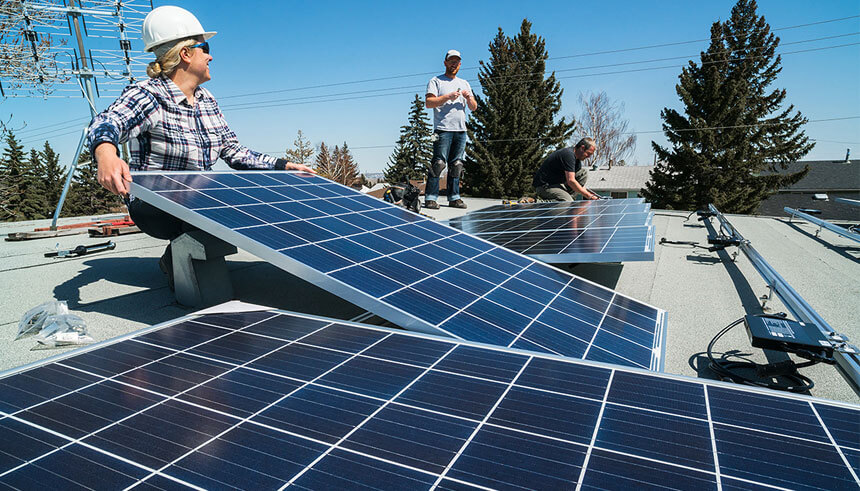Insights
Utilizing Solar Energy to Save Costs and Look Toward a Post-Pandemic Future
By

How COVID-19 impacted renewable energy and why solar developers are still optimistic
Although the COVID-19 pandemic has negatively impacted the solar energy industry like it has so many others, the overall outlook for solar power in the medium term is positive. The cost of solar installations has fallen by more than 70% since 2010, with costs in the first quarter of 2020 for both residential and utility-scale projects at their lowest yet. California, which currently has over 28,000 megawatts of solar capacity and gets over 20% of its electricity from solar, is leading the pack in the United States.
Although the demand for residential solar installations has fallen, demand for large-scale solar projects is estimated to drive the industry to 33% growth in 2020. According to Jacqueline DeSouza, president of energy management service Apparent, Inc., there is a lot of interest from investors in environmental, social and corporate governance (better known as ESG) projects, particularly in the solar and renewables sectors.
“Initially, there was definitely a downturn because access to property construction was cut off for months at a time [due to the pandemic]—but projects are now moving forward with speed,” explains DeSouza. “What we haven't seen is a slowdown in interest. So, even during the pandemic, we had numerous calls about solar installations and energy management of renewables, both solar and storage.”
Saving on energy during a pandemic
The COVID-19 pandemic has led to a nationwide budget crisis that has impacted many individuals and government-supported programs and institutions, including public schools. However, solar installations have helped thousands of schools save money at this critical time, according to a report by clean energy nonprofit Generation180, in partnership with The Solar Foundation and the Solar Energy Industries Association. The U.S. has over 7,300 K-12 schools that use solar power; since 2014, the number of schools with solar has grown by 81%, with California leading the states. Some school districts are expected to save as much as $43 million over 20 years, and other districts plan on putting the savings toward increasing teachers’ salaries by thousands of dollars per year.
Typically, schools and other non-profit organizations utilize the community solar model to cut down on the cost of installing solar photovoltaic (PV) panels. Instead of having to finance and find adequate space for their own installations, schools can just pay a subscription to a solar developer like East West Bank client GCL Solar Energy, Inc. for their power.
“Most schools have major utility costs and are considering installing solar panels by utilizing their rooftop, carport and other spaces,” says Frank Zhu, president and CEO of GCL Solar Energy. “Solar projects can really help them cut overall operating costs, and also improve their sustainable brand image and help enrollment. Various analyses revealed that big entities like schools stand to save the most with solar.”
Getting project financing right at the start of COVID-19
California-based GCL Solar Energy has been working in the U.S. solar industry since 2009 and has successfully developed over 700 gigawatts of solar power in the United States, including an 18-megawatt portfolio that provides cost-saving solar power for various California schools. Although this was a smaller solar project than GCL Solar typically works on, the company still thought it was a great addition to their portfolio.
The cost of solar installations has fallen by more than 70% since 2010, with costs for both residential and utility-scale projects in the first quarter of 2020 at their lowest yet.

However, since this particular portfolio was a smaller project, it wasn’t the most opportune time to seek financing during a pandemic. According to DeSouza, although there is still considerable interest from investors in enterprise-scale projects, smaller community ones were having more difficulty finding backers.
“People are anxious about where are they investing and how much are they investing, both in infrastructure, as well as in just investing,” she explains. “So, when you're talking about a smaller project, definitely there's been more pushback on the financing side.”
Zhu says they were looking at a number of different avenues, but GCL Solar’s past relationship with East West Bank pushed them to work with the bank once again. “I know East West Bank pretty well; East West Bank knows GCL very well,” says Zhu.

They began negotiations in February 2020 and only took about six weeks to close, despite the start of the COVID-19 pandemic and a statewide lockdown in California. The uncertainty of the situation threw everyone for a loop, but thanks to constant communication between East West Bank and the GCL team, they were able to close a $48 million financing package.
“We knew GCL,” emphasizes Chris Simeone, senior vice president and project finance relationship manager at East West Bank. “It ended up being a pretty good fit, so we were able to get this done in a pretty short timeline.”
Betting on a bright future for solar
In the first quarter of 2020, residential solar installations were on track for a record year nationally, installing 3.62 gigawatts-direct current of solar photovoltaic capacity—a 42% increase year-over-year and the largest Q1 ever. Despite reports that the COVID-19 pandemic has negated five years of solar industry growth due to production slowdowns and supply chain disruptions, the overall renewable energy industry has remained resilient—and Zhu believes that solar will remain at the forefront of the movement. Analysts expect solar to have a partial recovery in 2021, and overall demand for utility-scale solar systems remains, as more utilities announce aggressive solar procurement plans to meet state targets.
"Solar is not only the future, it’s a current necessity for the world. All over the United States, all over the world, solar is a very important source of power capacity."

“The renewable industry is really going through an important point, in terms of growth,” says DeSouza. “I think the business model has really matured, so people are looking for what the next stage is for the solar and storage industry—and its management, being able to produce all of the energy that you need, as well as to use that energy as an asset. I think that's the next transition stage for renewable energy.”
For Zhu, the future of renewable energy lies very much in solar. Although there are many types of renewable energy, solar is currently the most established and projects have a shorter development timeline compared to others.
“Literally, the sky’s the limit for solar,” says Simeone. “Solar is not only the future, it’s a current necessity for the world. All over the United States, all over the world, solar is a very important source of power capacity.”
Subscribe to the Reach Further Newsletter
Get inspiring stories in your inbox every month.

